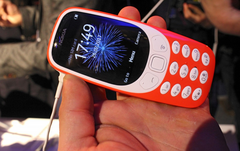When news that Nokia is planning to bring back its iconic 3310 with updated hardware this year, consumers all over the world wanted to know when they could get their hands on their devices. While the phone is light on fancy features, powerful specs and software customization options, its simple design and sturdy construction hearkens back to a time when mobile gaming was limited to apps like Snake and batteries could last for weeks.
Unfortunately for those living in the US, they may have to wait a little longer for their $50 nostalgia trip. One major roadblock stands in the way of the Nokia 3310 reaching the US market: US carriers don’t support the 900-MHz GSM band. HMD Global, who currently owns the Nokia brand, is still in the process of negotiating with carriers to sell Nokia-branded phones to ensure that these compatibility issues are ironed out.
Unlike other markets, US consumers tend to go through carrier stores to get their phones, so it is essential that Nokia strike a deal with them if it hopes to succeed in the country. “We’ll probably end with the US at some point,” said Patrick Mercanton, global head of marketing for HMD Global. “It’s definitely on our radar... we want to go into the US because we want to have a global launch.”
These words don’t seem encouraging, to say the least. This issue will have to be resolved in time for the 3310’s Q2 2017 release date, or else HMD may miss a window of opportunity.


 Deutsch
Deutsch English
English Español
Español Français
Français Italiano
Italiano Nederlands
Nederlands Polski
Polski Português
Português Русский
Русский Türkçe
Türkçe Svenska
Svenska Chinese
Chinese Magyar
Magyar
